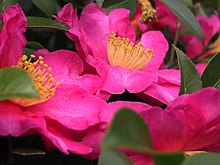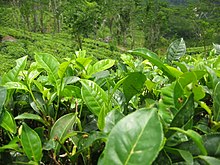Our website is made possible by displaying online advertisements to our visitors.
Please consider supporting us by disabling your ad blocker.
Camellia
| Camellia | |
|---|---|

| |
| Camellia sasanqua is used as a garden plant, its leaves are used for tea, and its seeds for oil | |
| Scientific classification | |
| Kingdom: | Plantae |
| Clade: | Tracheophytes |
| Clade: | Angiosperms |
| Clade: | Eudicots |
| Clade: | Asterids |
| Order: | Ericales |
| Family: | Theaceae |
| Genus: | Camellia L. |
| Species | |
|
About 100–250, see text | |
| Synonyms | |
|
Thea | |

Camellia is a genus of flowering plants in the family Theaceae, native to eastern and southern Asia from the Himalaya east to Japan and Indonesia. Scientists are still discussing how many species there are. The number of species varies between 100 and 250. Linnaeus named the genus inhonour of Fr. Georg Joseph Kamel, a Jesuit botanist. amel brought C. japonica from Manila to Spain.

They are evergreen shrubs and small trees from 2–20 m tall. The leaves are alternately arranged, simple, thick, serrated, usually glossy, and 3–17 cm long. The flowers are large and conspicuous, 1–12 cm diameter, with (in natural conditions) 5–9 petals; colour varies from white to pink and red, and yellow in a few species. The fruit is a dry capsule subdivided into 1–5 compartments, each containing 1–8 seeds.
The genus is generally adapted to acidic soils, and does not grow well on chalk or other calcium-rich soils. Most species also have a high rainfall requirement and will not tolerate drought.
Camellia species are used as food plants by the larvae of a number of butterfly species.
Previous Page Next Page


